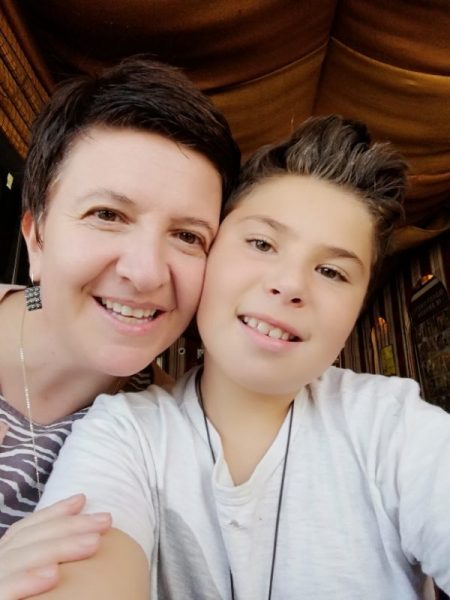Originally published in Source by Jeff Dodge

Gamze Cavdar’s son, Ada, had suffered from asthma since he was a toddler, and by the time he was 7 years old, his attacks were so bad that he was regularly missing school and being taken to the emergency room.
“We literally kept an overnight hospital bag in the car,” said Cavdar, an associate professor in the Department of Political Science at Colorado State University.
Ada’s doctors would put him on medications like steroids when his symptoms flared up after a cold, but they weren’t addressing the source of his asthma. So a frustrated Cavdar took matters into her own hands.
“I decided to read the medical literature myself, I was so upset,” she recalled. “I’m not a doctor, and it was a lot of work, but I was determined to get to the bottom of it.”
She spent the summer of 2015 researching the issue, and learned about the microbiome in our gut, where probiotics and a high-fiber diet can stimulate the growth of healthy bacteria that fight chronic diseases, including asthma. Cavdar decided to alter her son’s diet, replacing sugar and processed foods with high-fiber fruits, vegetables, whole grains and legumes, as well as probiotic-rich foods like kombucha and sauerkraut. She and her husband began making their own food from scratch, including yogurt, butter, cheese, yeast-free bread and fermented sausage and vegetables.
“It was a full-time job,” Cavdar said. “But it worked.”
Increased fiber
They incorporated high-fiber foods like beans, chickpeas and lentils into Ada’s meals, even in hamburgers. When he started to show signs of an oncoming asthma attack, they simply increased his fiber intake, and the symptoms subsided. Ada had no asthma attacks in the year that followed, and he went through a growth spurt, gaining weight and becoming more active. Cavdar said he was eating 40 to 50 grams of fiber a day.
“You’d have to eat a lot of broccoli to get to 50 grams, but if you eat chili for lunch and lentil soup for dinner, with fruits and vegetables in between and whole wheat bread, it’s possible,” she said.
Cavdar began looking for microbiome experts on campus, and found Elizabeth Ryan, an associate professor in CSU’s Department of Environmental and Radiological Health Sciences whose Toxicology and Nutrition Laboratory researches dietary interventions for improved gut health and immunity. Ryan recently completed a study in which a rice bran supplement for infants being weaned from their mother’s milk was found to provide nutrients that enhanced growth and reduced diarrhea.
Ryan invited Cavdar to join the interdisciplinary CSU Food Systems Research Group on campus, and the two began examining how breast milk can provide a baby with oligosaccharides, which are used by the developing gut microbiome to support growth, immunity and health.
“These interdisciplinary teams are important, because it’s how the hard sciences can get connected to public policy,” said Cavdar, whose expertise is politics in the Middle East. “This subject is still so new to me, but I really like it.”
Co-authored journal article

Cavdar and Ryan collaborated with then-undergraduate Theresa Papich on a journal article that proposes modifying U.S. dietary recommendations to address the importance of fiber in
breastfeeding mothers’ diets and creating a national paid parental leave policy that will help new mothers breastfeed for at least six months after their baby’s birth. (Surveys show that having to go back to work is a major factor for new mothers who decide to breastfeed for less than six months.) The article, “Microbiome, Breastfeeding and Public Health Policy in the United States: The Case for Dietary Fiber,” was published this summer in the Sage journal Nutrition and Metabolic Insights.
“This topic and paper were highly relevant to the research that my lab is doing on the health benefits of whole grains and legumes across the lifespan,” Ryan said. “Our research on the gut microbiome relates to evaluating the metabolism of fiber-rich foods, and also finding ways to help people increase consumption of fiber in their daily diet.”
Papich, who graduated in May 2018 with a degree in biomedical sciences, wrote her honors thesis about the microbiome with Ryan as an advisor. She now works as a research assistant for Rocky Mountain Poison & Drug Safety, a subsidiary of Denver Health, and is applying to medical schools. Papich performed the literature review for the article, and said having her work published in an academic journal as an undergraduate was rewarding.
“It was amazing,” Papich said. “I really felt honored that Dr. Ryan and Dr. Cavdar invited me to be part of this.”
Ryan added that Papich was invaluable in the process.
“Bringing in her ideas from her honors thesis was a big help to both Gamze and me, particularly when considering the linkages among microbiome, breastfeeding, dietary fiber and current nutrition guidelines and policies for lactating women,” Ryan said.
Public policy meets dietary fiber

While Cavdar covered the public policy side in the article’s arguments, Ryan and Papich discussed the science. Papich and Ryan agree that additional research is needed to assess how a
breastfeeding mother’s fiber-rich diet can benefit her human milk oligosaccharide contents, and thus the baby’s gut microbiome. But there are many established studies on how dietary fiber promotes the growth of beneficial bacteria in the gut and reduces the presence of harmful bacteria.
For example, a nine-year National Institutes of Health study of about 400,000 individuals ages 50 to 71 found that fiber, especially from whole grains, was associated with reduced death from respiratory and infectious diseases, most likely because increased fiber intake is associated with reduced levels of inflammatory markers.
Cavdar said changes must be made to the dietary recommendations for pregnant and lactating women issued by the U.S. Department of Health and Human Services and the World Health Organization. Currently, she said, those recommendations address things like calories, minerals and eating whole foods, but they are silent on the importance of dietary fibers. Cavdar also pointed out that the U.S. is the only country in the Organisation for Economic Co-operation and Development that doesn’t have a national paid parental leave policy.
“Yes, it may be costly to guarantee six months of paid leave, but public policies have to prioritize, and this is a very important policy to invest in for the next generation,” she said.
As for Cavdar’s son, Ada is 11 now and hasn’t had an asthma attack in four years.
“He rarely needs his inhaler, maybe once a year, and doesn’t need tablet or liquid steroids at all,” she said.
But Cavdar cautions that a high-fiber diet should not be viewed as a magic bullet.
“I don’t want people to get the message that they can stop their asthma medication and treat asthma at home with fiber,” Cavdar said. “After all, this was one person’s experience. Plus, I was extremely careful, and I only used fiber as a preventive measure, so we never replaced medication with fiber. Once somebody is showing severe asthma symptoms, there is really nothing one can do except for steroids.”